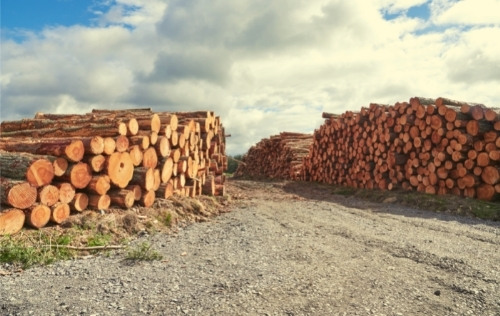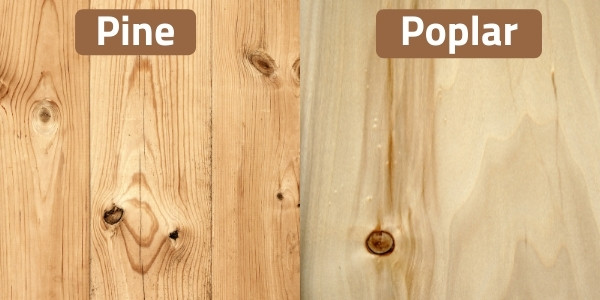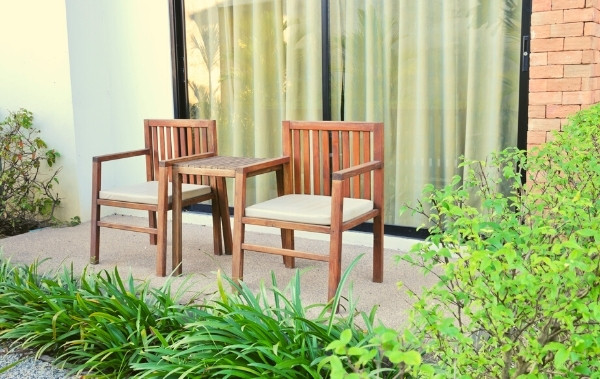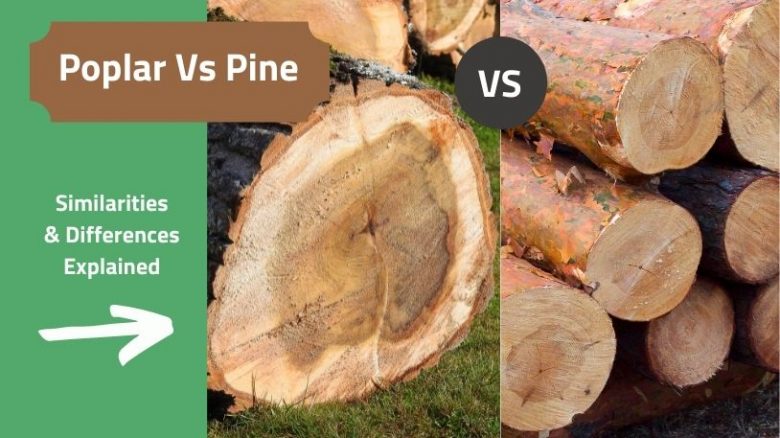Two wood species frequently used in woodworking projects are pine and poplar. We often receive requests for advice about the benefits of one over another, so today, we’ll take a deep dive into both kinds of wood and talk about density, durability, and price. We’ll also advise you on how each takes stains and paints and where you may choose one over the other.
When I started my woodworking career, pine was the only wood I could afford and had access to. These days, we’re spoiled for choice for timber, with a wide variety of local and exotic timbers available. I still reach for pine as a standby when I need to knock something up quickly, but there are applications where other timbers are more suited.
Stay with me for a few minutes, and we’ll run through a side-by-side comparison of poplar vs pine to give you the information needed for your next project.
Poplar vs pine: main differences
Hardwoods and softwoods
Given the two kinds of wood we’re comparing, let’s discuss the difference between hardwoods and softwoods, as pine is a softwood and poplar hardwood. Yet, the difference between the two kinds of wood is not as stark as you may think. Also, the terms do not mean that a hardwood is necessarily harder than a softwood.
Softwood is defined as wood from gymnosperm trees, such as spruce and pine. Gymnosperm trees have needle-like leaves and bear their seeds in cones, and, unlike many hardwoods, these trees are not deciduous, meaning they do not lose their leaves in autumn.
Hardwoods are timbers from angiosperm trees. These trees reproduce via flowers and have broad leaves. Many angiosperm trees are deciduous, losing their leaves in autumn in temperate climates or during seasonal droughts in warmer climates.
Therefore, your selection of wood should consider more specific characteristics, such as durability and hardness.
Hardness ratings
A useful hardness rating for wood exists called the Janka Rating. The name comes from an Austrian called Gabriel Janka, who developed a method of testing a piece of wood for its resistance to denting and wear.
In Janka’s test, a 0.444″ steel ball is forced into a piece of wood to half its circumference. The force required is measured in either foot-pounds or Newtons and recorded, allowing a comparison between different woods.
The results are not absolute figures. Depending on where the wood is from geographically and within the tree trunk, they differ. However, it does allow a general means of comparison between different wood species.
For our comparison of pine and poplar, here are some Janka ratings for the various pine species compared to poplar.
| Wood Species | Janka Rating (lbft) |
|---|---|
| Eastern White Pine | 380 |
| Western White Pine | 420 |
| Poplar | 540 |
| Southern Yellow Pine | 690 – 870 |
| Heart Pine | 1,225 |
| Red Pine, or Hornbeam | 1,630 |
When comparing these ratings to oak, which ranges between 1,290 and 1,360, walnut at 1,010 to 1,390, and maple between 700 and 1,450, you can see that pine and poplar are both quite softwoods.
Durability of poplar and pine
There is also a relative measure of durability that we can turn to when comparing our two kinds of wood. Various standards exist, but one helpful one is the British Standard EN 350:2016 with the delightful name “Durability of wood and wood-based products – Testing and classification of the durability to biological agents of wood and wood-based materials.”
This standard uses durability classes for a wood’s resistance against four destroying organisms: fungi (rot), wood-boring beetles, termites, and marine organisms. It also has annexes for a wood’s ability to be treated with preservatives and its permeability in water.
The different species of pine land in different classes depending on the species. Red, yellow, white, and southern pine are all Class Four durability, which means they’re slightly durable and last five to ten years. Poplar is Class five durability, meaning not durable, and lasting less than five years.
Here’s a table summarising some of the better-known woods.
Durability Class | Name | Wood Type |
1 - Very Durable (25+ years) | Accoya Wood | Yes |
Rosewood | Carbide tipped | |
Teak | 10-inch | |
Greenheard | ⅝-inch | |
Ironwood | Fixed w/ Castors | |
2 - Durable (15-25 years) | American Mahogany | Hardwood |
European Oak | Hardwood | |
Cedar | Softwood | |
Yew | Softwood | |
Sweet Chestnut | Hardwood | |
3 - Moderately Durable (10-15 years) | Cherry | Hardwood |
Walnut | Hardwood | |
European Larch | Softwood | |
Japanese Oak | Hardwood | |
Western Red Cedar | Softwood | |
4 - Slightly Durable (5-10 years) | Rock Maple | Hardwood |
Soft Maple | Hardwood | |
Red Pine | Softwood | |
African Walnut | Hardwood | |
European Redwood | Softwood | |
American Red Oak | Hardwood | |
5- Non Durable (Less than 5 years) | Poplar | Hardwood |
Pine | Softwood | |
Balsa | Hardwood | |
Basswood | Hardwood | |
European Ash | Hardwood | |
Spruce | Softwood | |
Alder | Hardwood |
Density
We’ve covered hardness and durability, yet there’s one more measure we should consider. Density will tell you what weight you can expect from your selected wood. The measure used is either pounds per cubic foot or kilograms per cubic meter.
Unfortunately, this metric won’t help much in selecting between pine and poplar as they are both in the same range. Excluding pitch pine, all the common pines and poplar fall into the 22 to 32 lb/ft3 or 350 to 500 kg/m3.
If you wish to find a chart that gives you these figures for the most common woods, you can find them here.
Price
The price of wood is a volatile measure, affected by season, weather, geographical location, and demand. Yet, at the time of writing, the UK, USA, and Canada prices were not too far apart regarding the percentage difference, with Poplar commanding a retail price premium of between 40 and 50% over pine.
If the project you are making is based solely on your budget, pine will win hands down. Yet, there are advantages and disadvantages to using pine, which may exclude it even though it’s cheaper.
Sustainability

As responsible woodworkers, sustainability has become an important decision in our wood choices for a project. In the case of timber, sustainable means it has been sourced from a producer using sustainable harvesting techniques. These techniques include a commitment to not damage ecosystems, watersheds, or wildlife in the production and harvesting of the timber.
One technique ensures that more seedlings are planted than trees taken. In the case of fast-growing timbers, this practice is not difficult. When dealing with slower-growing trees, such as oak, the forests require careful management.
Both pine and poplar are fast-growing trees and, therefore, more suited to sustainable production. Poplar and pine are two of the most efficient trees in terms of sustainability, given their rapid growth. In Europe, one cubic meter of poplar lumber can grow in 15 years, with pine even faster, considered mature, and harvestable in 10 years. Compare this to an oak that will take 100 years for the same volume.
Poplar vs pine: pros and cons of each
We’ve seen that Poplar and Pine have relatively low Janka ratings, so they’re soft. They’re similar in density, depending on the pine chosen, and both are capable of being sustainably sourced. They differ in price, with Poplar being more expensive. They also differ in durability, with most pine species being slightly more durable than poplar. However, there are three other deciding issues: grain, color, and finishing ability.
Grain

Both pine and poplar have a straight and uniform grain and medium texture, the differences being that pine has a somewhat oily feel, and poplar has a low natural luster. Be aware that pine can have knots and irregularities that affect the strength and appearance of the wood. If either of these characteristics is important to you and pine is your choice of timber, be careful when selecting your wood.
Color
Poplar is a white to creamy color with streaks of grey or green. Its colors tend to darken from light exposure. Pine varies in color from white through yellow to reddish-brown.
Finishing ability
Finishing is one area showing distinct differences between the two kinds of wood. Pine can be quite resinous, depending on the wood you purchase, and this characteristic can clog tool blades and demand more care when staining and painting. If you have resinous pine, you may need to seal the wood before applying your finish to prevent bleeding. Yet, pine takes paint, stain, and glue well if it’s dry or properly sealed.
Poplar is soft and can leave fuzzy surfaces and edges when sanding or shaping. This tendency requires you to sand to a finer grit before applying a finish. Poplar takes paints and glues well but does not stain consistently due to color changes.
Outdoor use?

We’ve discussed the durability of each wood, and neither is particularly durable, although pine can be treated if you wish to use it externally or for fencing and fence posts. Treated pine has a chemical called Tanalith soaked into it under pressure. Once treated, the wood takes on a soft green color and becomes more resistant to rot and insects. You can easily find treated pine at your wood supplier.
I’ve not yet met anyone who uses Poplar outside unless they wish to repeat their project in three to four years.
Related: Best Woods for Outdoor Furniture
Frequently Asked Questions
Which is better, poplar or pine?
There is no straight answer to this question and it all boils down to personal preference. Generally speaking, poplar is a bit harder, but neither is particularly durable.
Pine has a more oily feel and is more resinous, while poplar has a low natural luster.
Pine will generally have more irregularities and knots which have an impact on its appearance and strength.
Poplar is generally more expensive than pine.
How do you tell pine from poplar?
Pine generally has more knots and more irregular grain. Pine colors vary from white through yellow to reddish-brown. Poplar color is creamy white with streaks of grey or green.
Which is better for staining?
Both pine and poplar are far from being ideal for staining. Both kinds of wood are quite soft, which means that they take stains unevenly, which may create a poor look. Pine will take stains well if properly sealed. Poplar will require you to sand to a finer grit before applying a finish.
Which type of wood is harder?
Poplar is harder than pine with a Janka hardness score of 540 lbf vs white pine at 420 lbf. In the grand scheme of things, both types of wood are quite soft despite Poplar being a hardwood.
Which type of wood is more durable?
Both pine and poplar are class five – non-durable woods.
Which wood has a higher density?
Poplar and pine have a similar density (21.9 – 31.2 lb/ft³).
Which is cheaper, poplar or pine?
Depending on region and time of season, poplar is generally 40-50% more expensive than pine.
Which is more sustainable?
Both pine and poplar are fast-growing trees and, therefore, suitable for sustainable production. Poplar and pine are two of the most efficient trees in terms of sustainability. It takes around 15 years to grow a fully harvestable poplar tree, and pine is considered mature in 10 years. Oak, for example, will take 100 years to grow that same volume.
Summary
As you can see, there’s not a huge difference between the two kinds of wood, despite one being a hardwood and the other a softwood. Both are quite soft and easy to work with, having similar densities.
Poplar is more expensive and arguably easier to work with than pine, particularly if the pine is resinous or knotty. As to appearance, that is so subjective that only you can make that decision. Poplar doesn’t have the knots and blemishes that some pine has, yet some people prefer the pine look as they feel it’s more ‘rustic.’
If you’re going to stain your project, pine is your best bet. If it’s to be painted, either wood works, although be careful to seal any resinous pine.
Neither is particularly durable, although pine has a slight edge. Pine can also be chemically treated to suit external use and ground immersion.
The finishing issue aside, your decision will hinge on internal or external use, price, and appearance. I trust this article has given you the information needed to make the right decision for your project.

